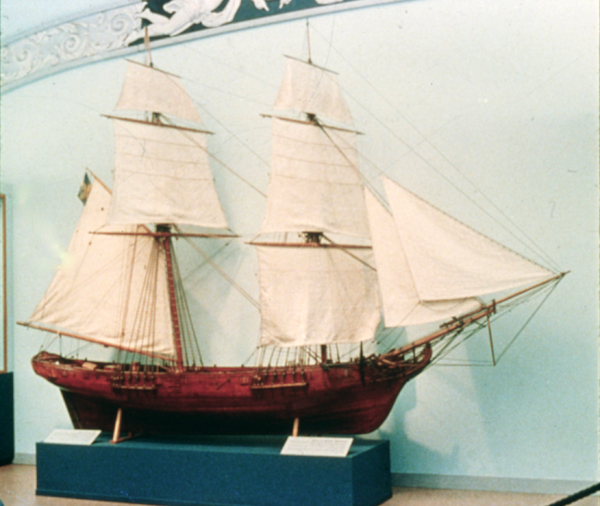Metta Catharina
Die Frau Metta Catharina von Flensburg was a brigantine, a two-masted sailing ship with the forward mast carrying square sails and the main mast carrying a fore and aft sail. The Catharina was built in 1782 at Rønshoved on the north shore of Flensburg Fjord, now in Denmark, and at the time of her loss carried 106 tonnes burden and had a crew of six. In December 1786 the Catharina was carrying a cargo of hemp and reindeer hide to Genoa from Saint Petersburg when worsening weather compelled her to seek shelter in Plymouth Sound. Unfortunately, on the night of 10th at about 10pm a south-westerly gale tore the Catharina from her anchorage towards Drakes Island, luckily it was high spring tide and the vessel was thrown over the rocks that lie between Drake’s Island and the Cornish shore. Miraculously the entire crew managed to escape before the Catharina sank in 30m of water under Raveness Point.
The wreck lay forgotten for nearly 200 years before the chance discovery of a bronze bell on the seabed in the Barnpool by members of Plymouth Sound BSAC in October 1973. The divers had been using swim lines to search the Barn Pool starting at Wilderness Point and heading south-south-east, looking for the remains of the Harwich, a 70 gun 3rd rate warship lost in the Barnpool in the same storm that sank the Coronation off Penlee Point, and a privateer called La Victoire. The markings on the bell were unusually helpful as they gave the name of a ship, the type of ship and the date she was built. As well as the bell the divers initially found an iron ring and a number of rolls of leather protruding from the seabed hinting that more may lie beneath the seabed.
Under the leadership of Ian Skelton, the Nautical Archaeology Section of Plymouth Sound BSAC excavated the wreck between October 1973 and the end of the project in 2006. The team experimented with a number of mapping and excavating methods over the years in very difficult conditions; at a conference in 1980 the archaeologist Keith Muckelroy stated that this was the ‘most difficult underwater archaeological project in the UK’. The team discovered three quarters of the ship preserved in the muddy seabed, including hundreds of rolls of preserved reindeer hides in the holds. These hides are so well preserved in fact that shoes, cases, bags and belts have all been made from recovered leather, many by Robin Snelson, a leather craftsman of Penryn. Proceeds from the sale of the hides provided funds for the further investigation of the wreck and the recovery of artefacts. The sediments in the area provide the ideal preservation environment and have allowed many delicate objects to survive intact. As well as the leather the team were able to excavate, raise and conserve a number of objects including ceramic plates and flagons, clay pipes, intact glass bottles, a delicate wine glass, a candle holder and navigational equipment. The lower part of the ship itself also survived in very good condition, the upperworks having been eroded away, so the team could record in great detail the construction of an 18th Century brigantine (1).
Having worked on the site for 33 years the team leader wished to retire, and as no successor was found the project was stopped. The site was tidied up, some larger objects were placed in the trenches and they were allowed to backfill naturally with sediment.
Wrecks found in some parts of the West Country become the property of the Duchy of Cornwall so as Duke of Cornwall, Prince Charles was presented with the Catharina’s bell at the BSAC 21st Anniversary banquet in London. The Duchy had already granted the team a lease on the seabed allowing them to survey and excavate the site but as a further goodwill gesture the Prince, in his capacity as President of the BSAC, presented the bell to the diving club as a gift.
Diving the Catharina
The remains of the Metta Catharina lie in the Barn Pool, 230 metres to the north of the Bridges at the bottom of the northern slope in 30m depth. The seabed is very silty with a few stones and shells, the site is usually quite dark with visibility varying from less than a metre to a few metres. Since the team stopped working on the site the trenches have naturally filled with sediment and the ship now lies completely buried in the seabed.
Catharina Museum Exhibition

in 2011, artefacts recovered from the Metta Catharina were put on display in a museum exhibition at Mount Edgcumbe House in Cornwall. The SHIPS Project were pleased to be able to help with theis project, which you can read more about here.
Images
A model of a brigantine similar to the Metta Catharina |
References
The Metta Catharina Trust produced a 43 minute DVD called The Loss of the Metta Catharina in 1786, narrated by Ian Skelton, and a book by Ian Skelton in 2013 called Shipwreck: the Loss of the Metta Catharina in 1786, ISBN 978-0-9575692-0-1. More technical information about the site can be found in the 2010 paper Die Frau Metta Catharina von Flensburg: a Danish brigantine wrecked in 1786 in Plymouth Sound, England, published in the International Journal of Nautical Archaeology 39:2, pp235-257.

